Lung Cancer Staging
Cancer staging is the process of gathering information to determine the location and extent of the lung cancer and if it has spread to other parts of the body. The information gathered from the staging process determines the stage of the disease, which assists the medical oncologist in understanding the seriousness of the cancer, providing an optimal treatment plan, identifying potential clinical trials for viable treatment options, and even providing chances of survival.
After determining a diagnosis of small cell or non-small cell lung cancer, additional testing determines if the cancer cells have spread within the chest or to other parts of the body. Information gathered determines the stage of the disease and the treatment plan.
Determining the Stage of Small Cell Lung Cancer (SCLC)
Additional tests and procedures that may be used in the staging process include:
- Laboratory tests
- Bone marrow aspiration and biopsy: The removal of bone marrow, blood, and a small piece of bone by inserting a hollow needle into the hipbone or breastbone. A pathologist views the bone marrow, blood, and bone under a microscope to look for signs of cancer.
- MRI (magnetic resonance imaging)
- Endoscopic ultrasound (EUS)
- Lymph node biopsy: The removal of all or part of a lymph node. A pathologist views the tissue under a microscope to look for cancer cells.
- Radionuclide bone scan
Stages of Small Cell Lung Cancer:
- Limited-Stage Small Cell Lung Cancer: In limited-stage small cell lung cancer, cancer is found in one lung, the tissues between the lungs, and nearby lymph nodes only.
- Extensive-Stage Small Cell Lung Cancer: In extensive-stage small cell lung cancer, cancer has spread outside of the lung in which it began or to other parts of the body.
Determining the Stage of Non-Small Cell Lung Cancer (NSCLC)
Additional tests and procedures that may be used in the staging process include:
- Lymph node biopsy
- Mediastinoscopy: A surgical procedure to look at the organs, tissues, and lymph nodes between the lungs for abnormal areas. An incision (cut) is made at the top of the breastbone, and a mediastinoscope is inserted into the chest. A mediastinoscope is a thin, tube-like instrument with a light and a lens for viewing. It may also have a tool to remove tissue or lymph node samples, which are checked under a microscope for signs of cancer.
- Anterior mediastinotomy: A surgical procedure to look at the organs and tissues between the lungs and between the breastbone and heart for abnormal areas. This is also called the Chamberlain procedure.
Stages of Small Cell Lung Cancer
Occult (hidden) stage
In the occult (hidden) stage, cancer cells are found in sputum (mucus coughed up from the lungs), but no tumor can be found in the lung by imaging or bronchoscopy, or the primary tumor is too small to be checked.
Stage 0 (Carcinoma in Situ)
In stage 0, abnormal cells are found in the innermost lining of the airways. These abnormal cells may become cancer and spread into nearby normal tissue. Stage 0 is also called carcinoma in situ (localized).
Stage I
Cancer has formed. Stage I is divided into stages IA and IB:
Stage IA: The tumor is in the lung only and is 3 centimeters or smaller.
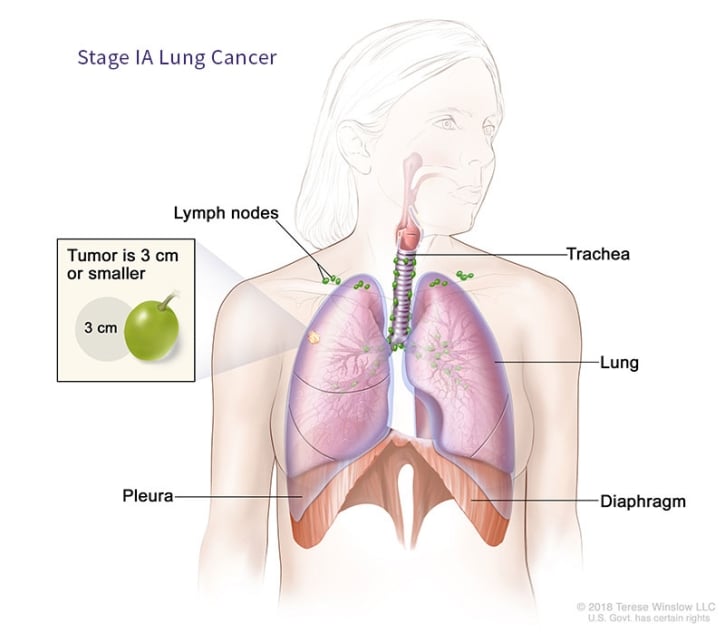
Stage IB: One or more of the following is true:
- The tumor is larger than 3 centimeters.
- Cancer has spread to the main bronchus of the lung, and is at least 2 centimeters from the carina (where the trachea joins the bronchi).
- Cancer has spread to the innermost layer of the membrane that covers the lungs.
- The tumor partly blocks the bronchus or bronchioles and part of the lung has collapsed or developed pneumonitis (inflammation of the lung).
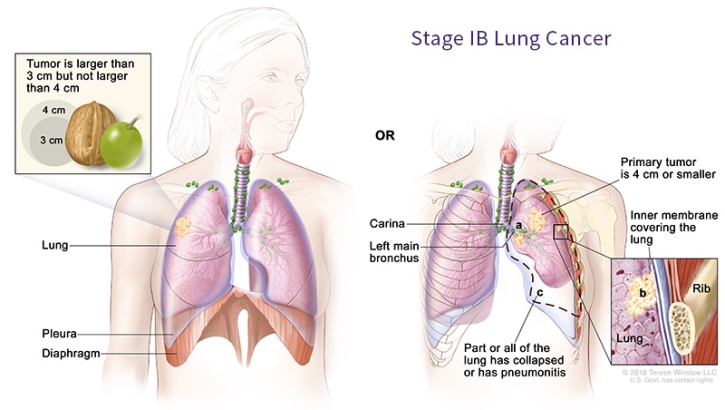
Stage II
Stage IIA: The tumor is larger than 4 centimeters but not larger than 5 centimeters or smaller and cancer has spread to nearby lymph nodes on the same side of the chest as the tumor.
Stage IIB (1): The tumor is 5 centimeters or smaller and cancer has spread to lymph nodes on the same side of the chest as the primary tumor. The lymph nodes with cancer are in the lung or near the bronchus. Also, one or more of the following may be found:
- Cancer has spread to the main bronchus, but has not spread to the carina.
- Cancer has spread to the innermost layer of the membrane that covers the lung.
- Part of the lung or the whole lung has collapsed or has developed pneumonitis.
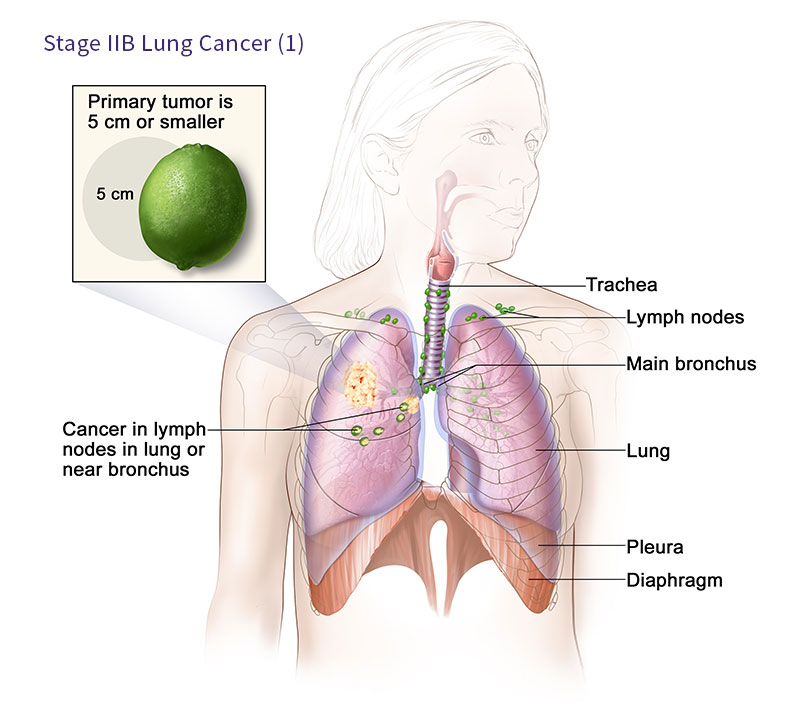
Stage IIB (2): Cancer has not spread to the lymph nodes and one or more of the following is found:
- The tumor is larger than 5 centimeters but not larger than 7 centimeters.
- There are one or more separate tumors in the same lobe of the lung as the primary tumor.
- Cancer has spread to any of the following:
- The membrane that lines the inside of the chest wall.
- Chest wall.
- The nerve that controls the diaphragm.
- Outer layer of tissue of the sac around the heart.
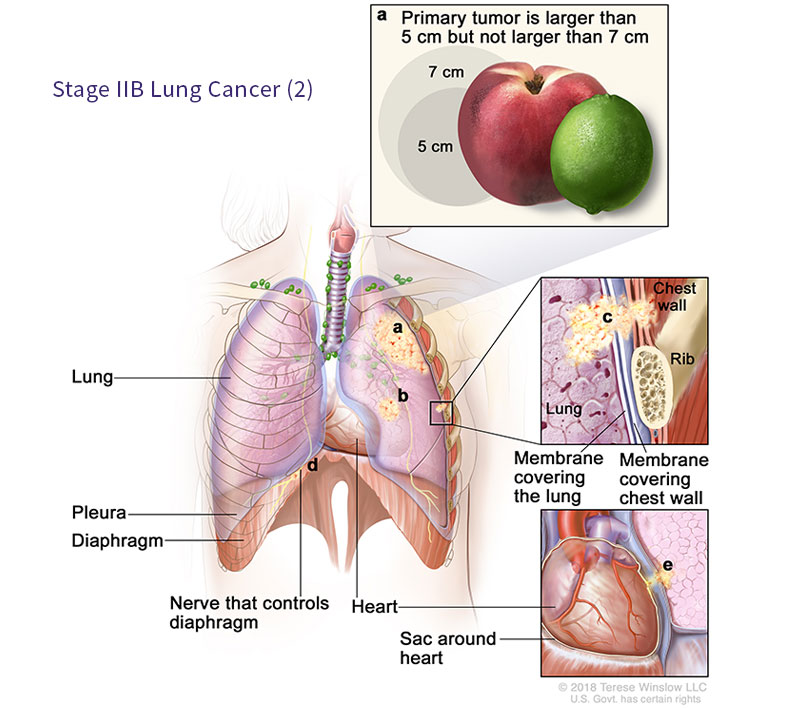
Stage III
Stage IIIA (1): The tumor is 5 centimeters or smaller and cancer has spread to lymph nodes on the same side of the chest as the primary tumor. The lymph nodes with cancer are around the trachea or aorta, or where the trachea divides into the bronchi. Also, one or more of the following may be found:
- Cancer has spread to the main bronchus, but has not spread to the carina.
- Cancer has spread to the innermost layer of the membrane that covers the lung.
- Part of the lung or the whole lung has collapsed or has developed pneumonitis.
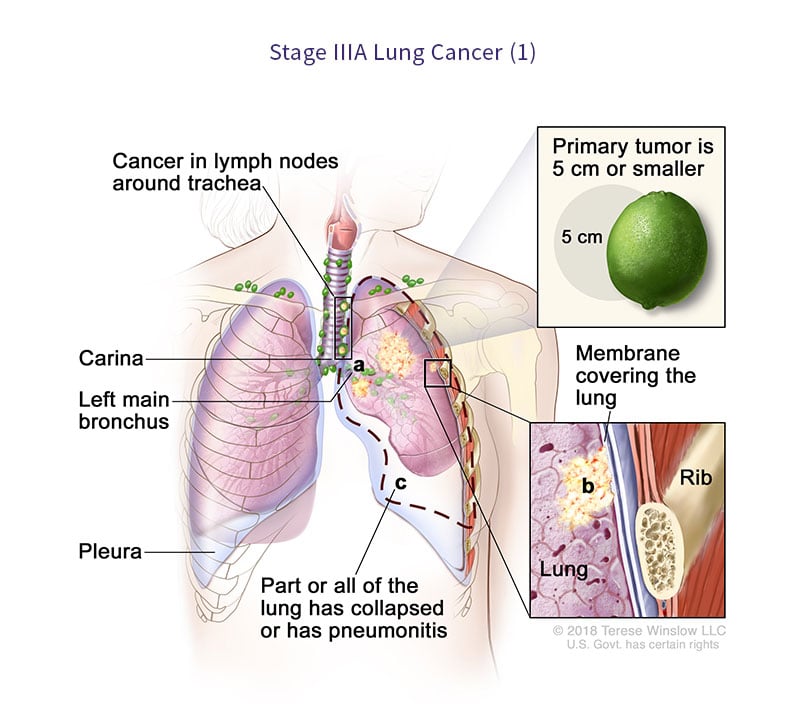
Stage IIIA (2): Cancer has spread to lymph nodes on the same side of the chest as the primary tumor. The lymph nodes with cancer are in the lung or near the bronchus. Also, one or more of the following is found:
- The tumor is larger than 5 centimeters but not larger than 7 centimeters.
- There are one or more separate tumors in the same lobe of the lung as the primary tumor.
- Cancer has spread to any of the following:
- The membrane that lines the inside of the chest wall.
- The nerve that controls the diaphragm.
- Outer layer of tissue of the sac around the heart.
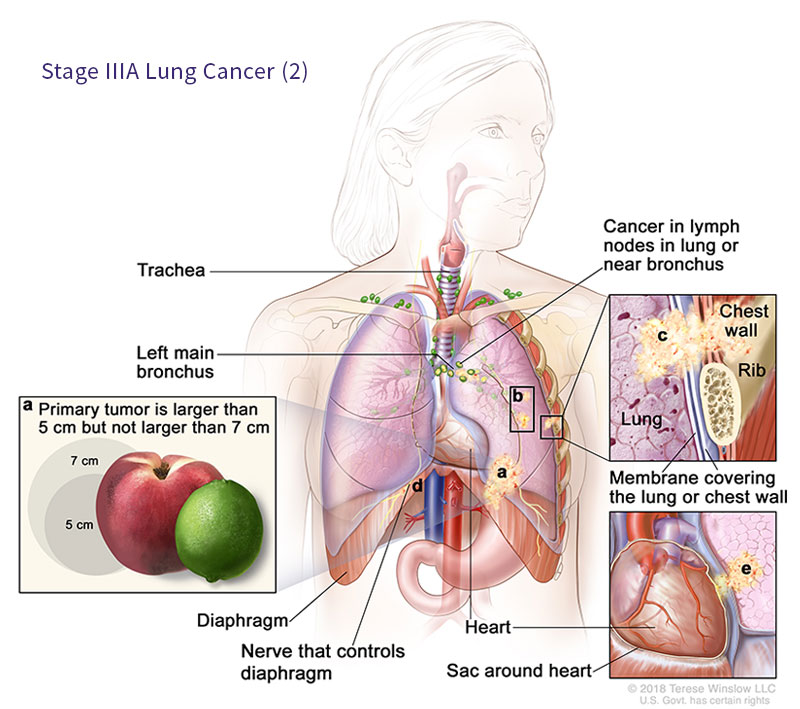
Stage IIIA (3): Cancer may have spread to lymph nodes on the same side of the chest as the primary tumor. The lymph nodes with cancer are in the lung or near the bronchus. Also, one or more of the following is found:
- The tumor is larger than 7 centimeters.
- There are one or more separate tumors in a different lobe of the lung with the primary tumor.
- The tumor is any size and cancer has spread to any of the following:
- Trachea.
- Carina.
- Esophagus.
- Breastbone or backbone.
- Diaphragm.
- Heart.
- Major blood vessels that lead to or from the heart (aorta or vena cava).
- Nerve that controls the larynx (voice box).
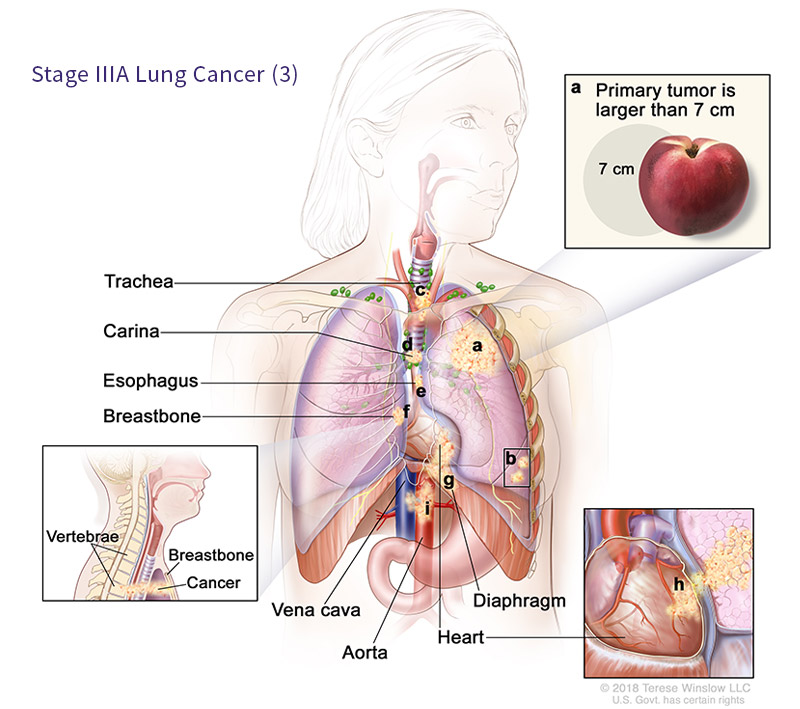
Stage IIIB (1): The tumor is 5 centimeters or smaller and cancer has spread to lymph nodes above the collarbone on the same side of the chest as the primary tumor or to any lymph nodes on the opposite side of the chest as the primary tumor. Also, one or more of the following may be found:
- Cancer has spread to the main bronchus, but has not spread to the carina.
- Cancer has spread to the innermost layer of the membrane that covers the lung.
- Part of the lung or the whole lung has collapsed or has developed pneumonitis.
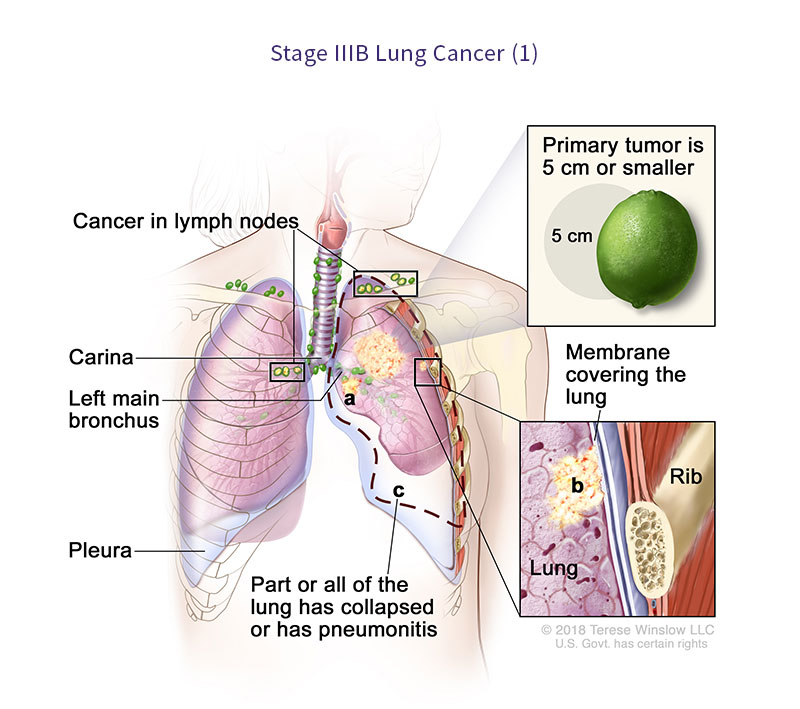
Stage IIIB (2): The tumor may be any size and cancer has spread to lymph nodes on the same side of the chest as the primary tumor. The lymph nodes with cancer are around the trachea or aorta, or where the trachea divides into the bronchi. Also, one or more of the following is found:
- There are one or more separate tumors in the same lobe or a different lobe of the lung with the primary tumor.
- Cancer has spread to any of the following:
- The membrane that lines the inside of the chest wall.
- Chest wall.
- The nerve that controls the diaphragm.
- Outer layer of tissue of the sac around the heart.
- Trachea.
- Carina.
- Esophagus.
- Breastbone or backbone.
- Diaphragm.
- Heart.
- Major blood vessels that lead to or from the heart (aorta or vena cava).
- Nerve that controls the larynx (voice box).
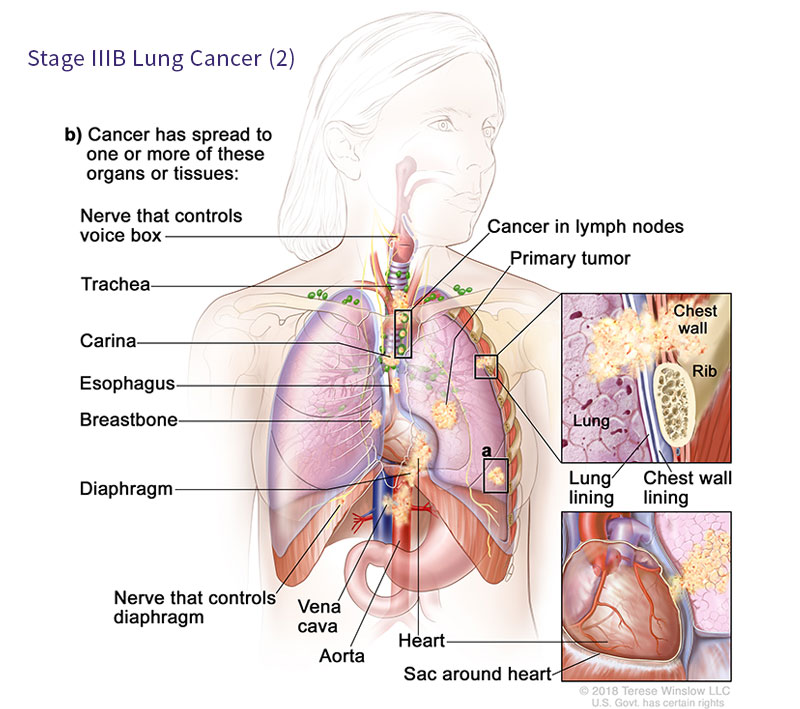
Stage IIIC: The tumor may be any size and cancer has spread to lymph nodes above the collarbone on the same side of the chest as the primary tumor or to any lymph nodes on the opposite side of the chest as the primary tumor. Also, one or more of the following is found:
- There are one or more separate tumors in the same lobe or a different lobe of the lung with the primary tumor.
- Cancer has spread to any of the following:
- The membrane that lines the inside of the chest wall.
- Chest wall.
- The nerve that controls the diaphragm.
- Outer layer of tissue of the sac around the heart.
- Trachea.
- Carina.
- Esophagus.
- Breastbone or backbone.
- Diaphragm.
- Heart.
- Major blood vessels that lead to or from the heart (aorta or vena cava).
- Nerve that controls the larynx (voice box).
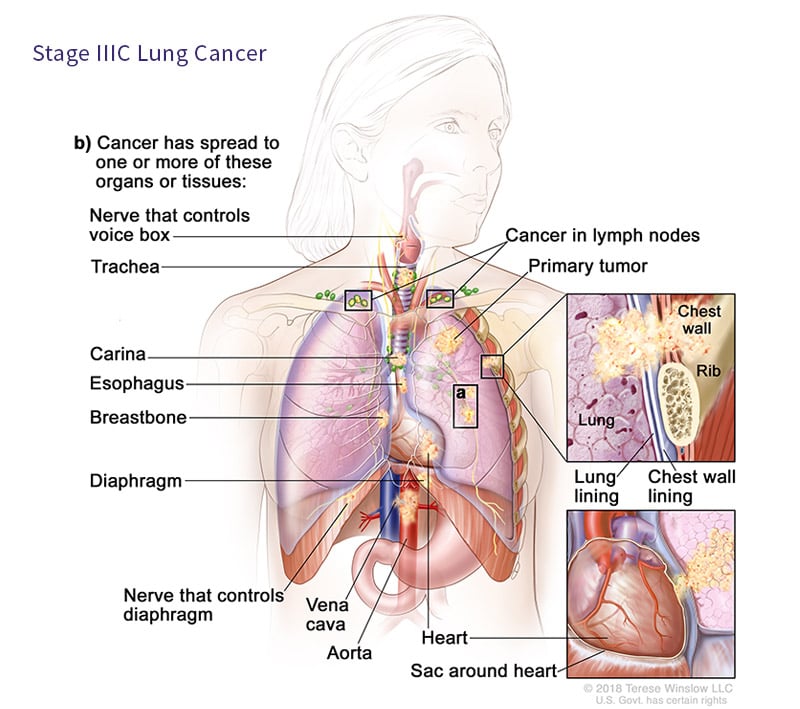
Stage IV
Stage IVA: The tumor may be any size and cancer may have spread to the lymph nodes. One or more of the following is found:
- There are one or more tumors in the lung that does not have the primary tumor.
- Cancer is found in the lining around the lungs or the sac around the heart.
- Cancer is found in fluid around the lungs or the heart.
- Cancer has spread to one place in an organ not near the lung, such as the brain, liver, adrenal gland, kidney, bone, or to a lymph node that is not near the lung.
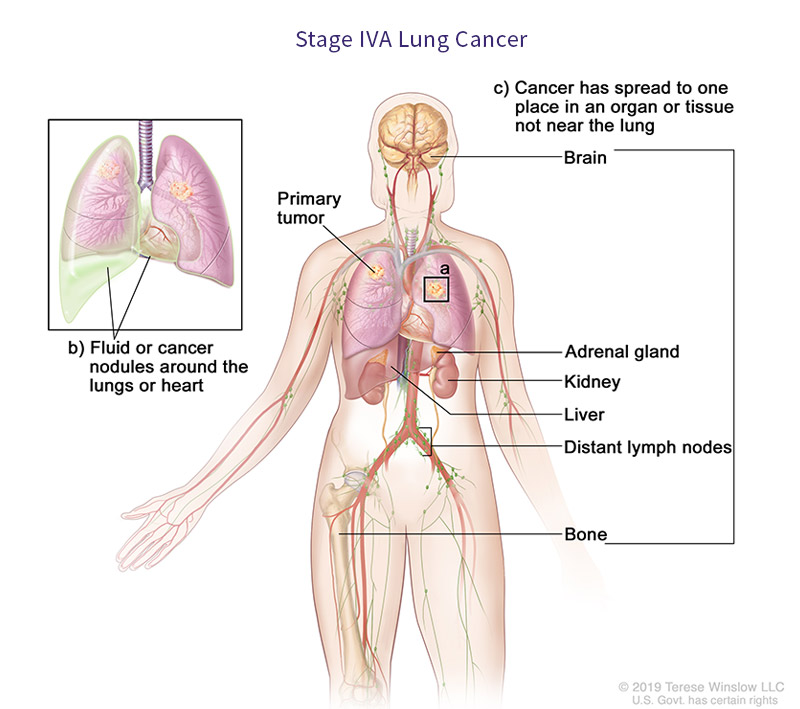
Stage IVB: Cancer has spread to multiple places in one or more organs that are not near the lung.
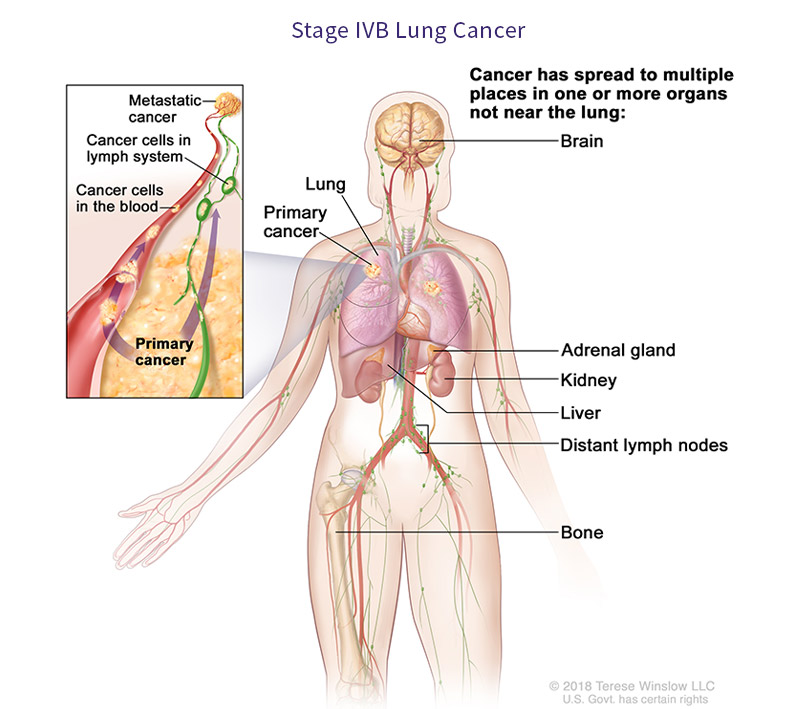
Lung Cancer Care and Treatment in Hampton Roads & Eastern North Carolina
If you or a loved one have been newly diagnosed with lung cancer, our oncologists specialize in lung cancer and are ready to talk to you about your diagnosis and personalized treatment options for lung cancer. The comprehensive and compassionate approach offered by our team at Virginia Oncology Associates combines advanced treatments with education and support services. Our cancer centers are located throughout Hampton Roads and the Eastern North Carolina area, including Virginia Beach, Norfolk, Hampton, Williamsburg, Chesapeake, Suffolk, and Elizabeth City. Request an appointment at a location nearest you to consult with one of our oncologists about treatment plans for lung cancer.


